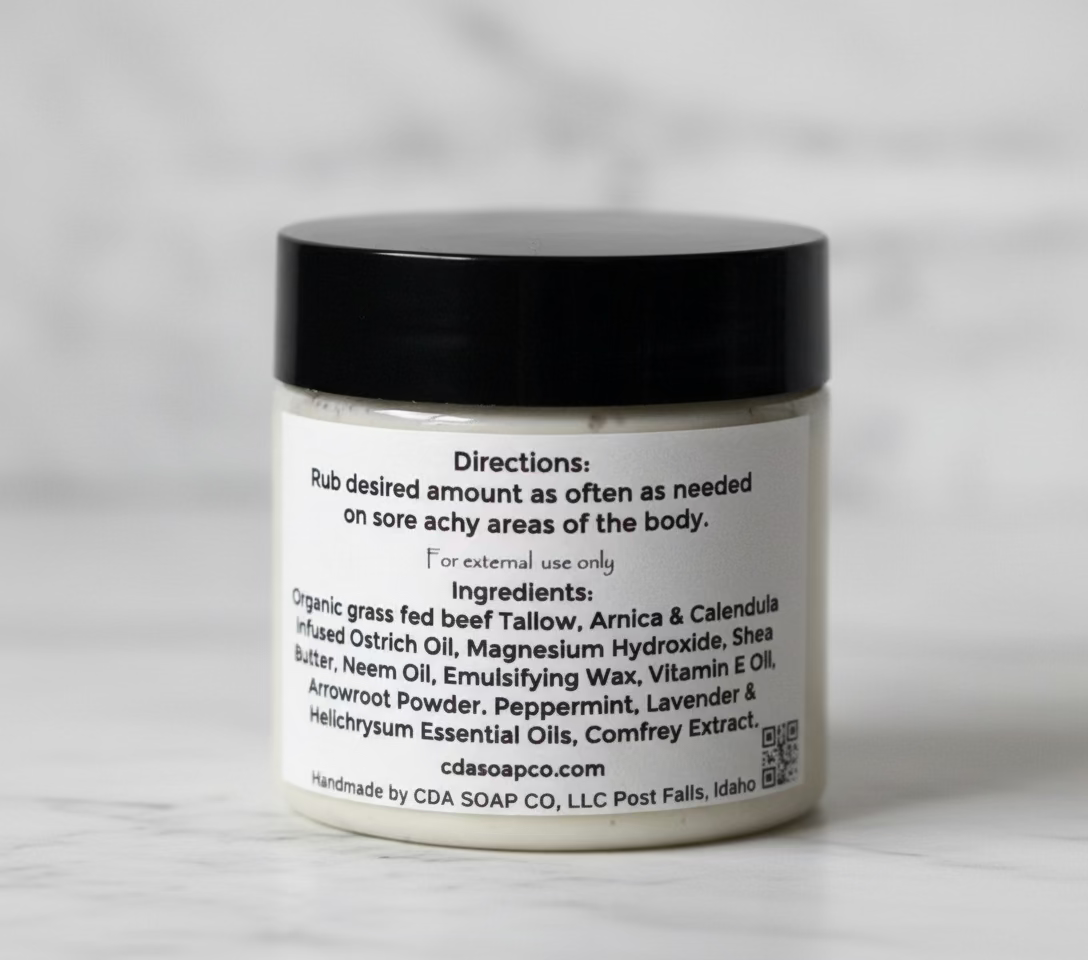Cdasoapco
Tallow & Ostrich Magnesium Butter
Tallow & Ostrich Magnesium Butter
Couldn't load pickup availability
Tallow & Ostrich Magnesium Butter
Deep Nourishment • Targeted Relief • Whole-Body Wellness
Available in 2 oz ($16) and 6 oz ($45) sizes
PLEASE NOTE: I use unrefined shea butter which has more nutrients but is very finicky to work with and often results in a grainy texture. A lot of makers stop using shea butter for this reason, however it plays a big role in this butter so I am not removing it. The graininess is perfectly safe to use and rubs in however if you have sensory issues you may not like this butter. Another side note. I am almost out of the glass 6oz jars and will be switching to wide mouth PET BPA FREE plastic for ease of use and safety as several have mentioned dropping and breaking the glass jar.
This powerhouse body butter blends ancient wisdom with modern science to deliver intense hydration, skin barrier support, and soothing relief for muscles and joints. Crafted with grass-fed tallow, ostrich oil, magnesium, and a curated blend of botanicals, it’s designed for all skin types—including sensitive, mature, and reactive skin.
Why Grass-Fed Tallow?
Tallow from grass-fed cattle is uniquely compatible with human skin due to its similarity to sebum, allowing it to absorb deeply and nourish from within. It’s naturally rich in:
-
Vitamins A, D, E & K – Support skin renewal, elasticity, and antioxidant protection
-
Conjugated Linoleic Acid (CLA) – A rare essential fatty acid that helps skin retain moisture and stay hydrated
-
Antioxidants & Nutrients – Promote healing and protect against environmental stressors
Unlike conventional moisturizers, this formula uses whole, bioavailable ingredients that work in harmony with your skin—not against it.
Ostrich Oil: The Unsung Hero
Ostrich oil is packed with omega fatty acids and antioxidants that help:
-
Hydrate and soften dry, irritated skin
-
Support wound healing and improve elasticity
-
Calm inflammation and soothe discomfort
-
May offer relief for eczema, psoriasis, and joint stiffness*
Its synergy with tallow enhances absorption and amplifies skin benefits, making this butter ideal for both skincare and topical recovery.
Magnesium + Botanicals for Relief
This formula goes beyond hydration. It’s infused with:
-
Magnesium – Supports muscle recovery, reduces soreness, and promotes tissue regeneration
-
Arnica & Comfrey – Traditionally used to ease bruises, sprains, and joint pain
-
Shea Butter – Moisturizes deeply while improving circulation and calming inflammation
-
Neem Oil – Known for its anti-inflammatory and skin-soothing properties
-
Calendula – Hydrates, protects, and supports skin barrier function
-
Helichrysum & Peppermint Oils – Help reduce swelling, improve circulation, and relieve tension
-
Lavender Essential Oil – Promotes relaxation and soothes irritated skin
-
Vitamin E – Shields skin from oxidative stress and supports collagen production
How to Use
Massage a small amount into clean skin, focusing on dry areas, sore muscles, or joints. Use daily or as needed for hydration and relief.
Why Customers Love It
-
All-natural, nutrient-dense ingredients
-
Suitable for all skin types, including sensitive and baby skin
-
Multi-functional: hydrates, heals, and soothes
-
No artificial fragrances, dyes, or fillers
-
Handmade in small batches for quality and freshness
This isn’t just a moisturizer—it’s a full-body wellness ritual. Whether you're looking to hydrate, calm inflammation, or support recovery, this butter delivers results you can feel.
Share






I use this on injuries, sore muscles, or joint pain and it has almost always relieved the pain completely, and very quickly. It seems to work better than either arnica or magnesium by themselves.
Fractured my ankle and used the tallow & ostrich magnesium daily for healing. I feel it really helped. High quality ingredients and product.






